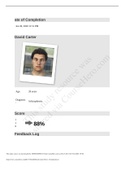Lecture notes
C83 LDC: Autism (2 x lectures) with extra reading.
- Institution
- The University Of Nottingham (UON)
Full highlighted notes from two autism lectures. Includes diagnosis, prevalence, vaccinations, environmental, genetic and neurological factors, theory of mind, central coherance and the autistic brain. 17 pages of notes, including extra reading.
[Show more]












